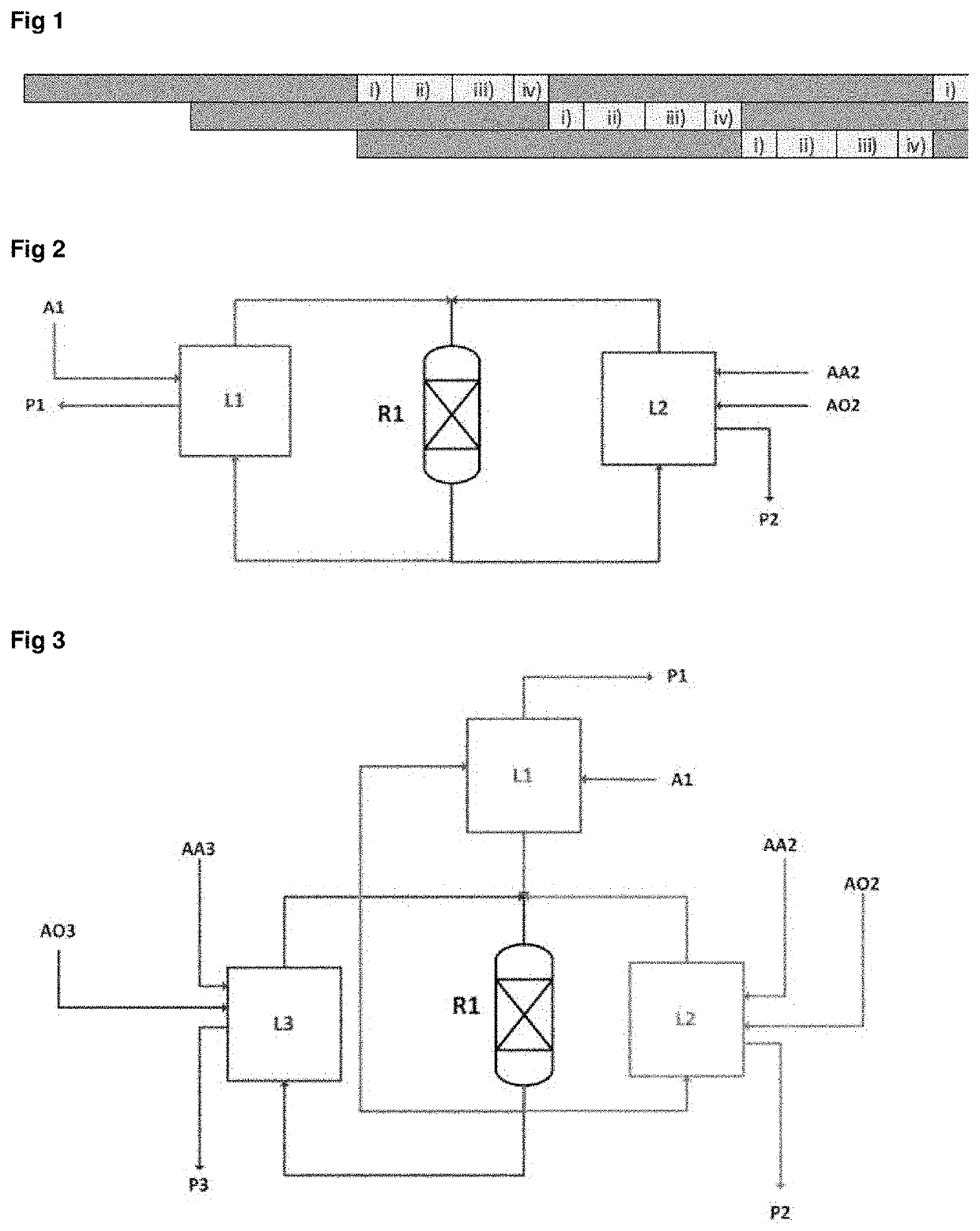Process for producing butadiene from ethanol with in situ regeneration of the catalyst of the second reaction step
a technology of butadiene and in situ regeneration, which is applied in the direction of catalyst regeneration/reactivation, physical/chemical process catalysts, metal/metal-oxide/metal-hydroxide catalysts, etc., can solve the problems of complex protocol for regeneration in particular of catalysts, the production of a wide variety of impurities, and the problem of all the more difficult to solve, so as to avoid premature degradation of catalysts and reduce the effect of catalyst degradation and regeneration performan
- Summary
- Abstract
- Description
- Claims
- Application Information
AI Technical Summary
Benefits of technology
Problems solved by technology
Method used
Image
Examples
examples
[0083]The following examples are based on simulations of processes incorporating thermodynamic data set up on experimental points.
[0084]In each of the following examples, the process described is incorporated into a more global process such as the one described in French patent FR 3 026 100. The ethanol feedstock for the global process is obtained from a renewable source and comprises more than 93% by weight of ethanol. The flow rate of feedstock feeding the global process is adjusted so as to obtain an annual production of 150 kt / year of a butadiene having a purity of between 99.5% and 100% by weight (compatible with the current use of the product), with an annual duration of functioning of the process of 8000 hours.
[0085]In the following examples, the term “variation(s) of composition” means the mean amplitude(s) of variation of the weight contents of the compounds of the reaction effluent, over the duration of functioning.
example a1 (
Not in Accordance)
[0086]In this example, the regeneration section comprises one regeneration loop per reactor.
[0087]The conversion of ethanol into acetaldehyde is performed in a multitubular reactor comprising a catalyst based on copper oxide on a silica support, at 275° C. and 0.26 MPa. The ethanol / acetaldehyde effluent, separated from the hydrogen stream at the reactor outlet, is then sent to the second reaction unit.
[0088]The second reaction unit comprises three radial fixed-bed reactors, each containing a fixed bed of a catalyst based on tantalum oxide on a silica-based matrix. In the second reaction unit, the conversion into butadiene is performed in the radial fixed-bed reactors, at 380° C. and 0.2 MPa and at an hourly space velocity (HSV) of 1.2 h-1. Supplies of ethanol and of acetaldehyde, obtained from the sections for purification and separation of the unconverted ethanol and acetaldehyde streams downstream of the reaction units, are added to the ethanol / acetaldehyde efflu...
example a2 (
in Accordance)
[0091]In this example, the second reaction unit comprises two regeneration loops: a nitrogen loop and a loop for the N2+O2 gas streams.
[0092]The conditions for the conversion of ethanol into acetaldehyde and for the conversion of the ethanol / acetaldehyde mixture into butadiene are the same as those of Example A1. The second reaction unit comprises three radial fixed-bed reactors comprising the same catalyst based on tantalum oxide as that described in Example A1. As for Example A1, the catalytic cycle of the catalyst based on tantalum oxide is 10 days. The three radial fixed-bed reactors function as for Example A1, in parallel and in sequence with a time offset of 5 days (cf. the scheme of FIG. 1). The regeneration of the catalyst based on tantalum oxide follows the protocol presented in Table 1. The regeneration section comprises a nitrogen loop for providing the nitrogen stream required for the regeneration, purifying it and recycling it, and an oxygen loop for ensur...
PUM
| Property | Measurement | Unit |
|---|---|---|
| pressure | aaaaa | aaaaa |
| pressure | aaaaa | aaaaa |
| temperature | aaaaa | aaaaa |
Abstract
Description
Claims
Application Information
 Login to View More
Login to View More - R&D
- Intellectual Property
- Life Sciences
- Materials
- Tech Scout
- Unparalleled Data Quality
- Higher Quality Content
- 60% Fewer Hallucinations
Browse by: Latest US Patents, China's latest patents, Technical Efficacy Thesaurus, Application Domain, Technology Topic, Popular Technical Reports.
© 2025 PatSnap. All rights reserved.Legal|Privacy policy|Modern Slavery Act Transparency Statement|Sitemap|About US| Contact US: help@patsnap.com

